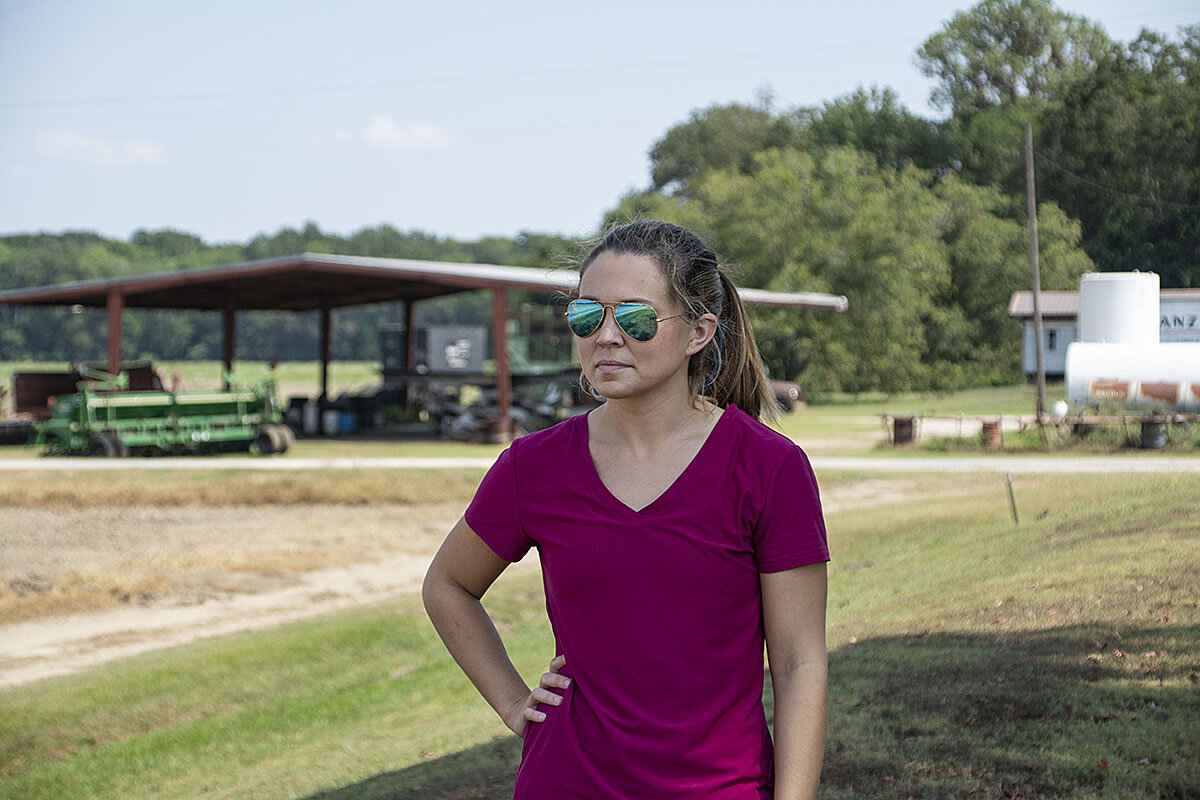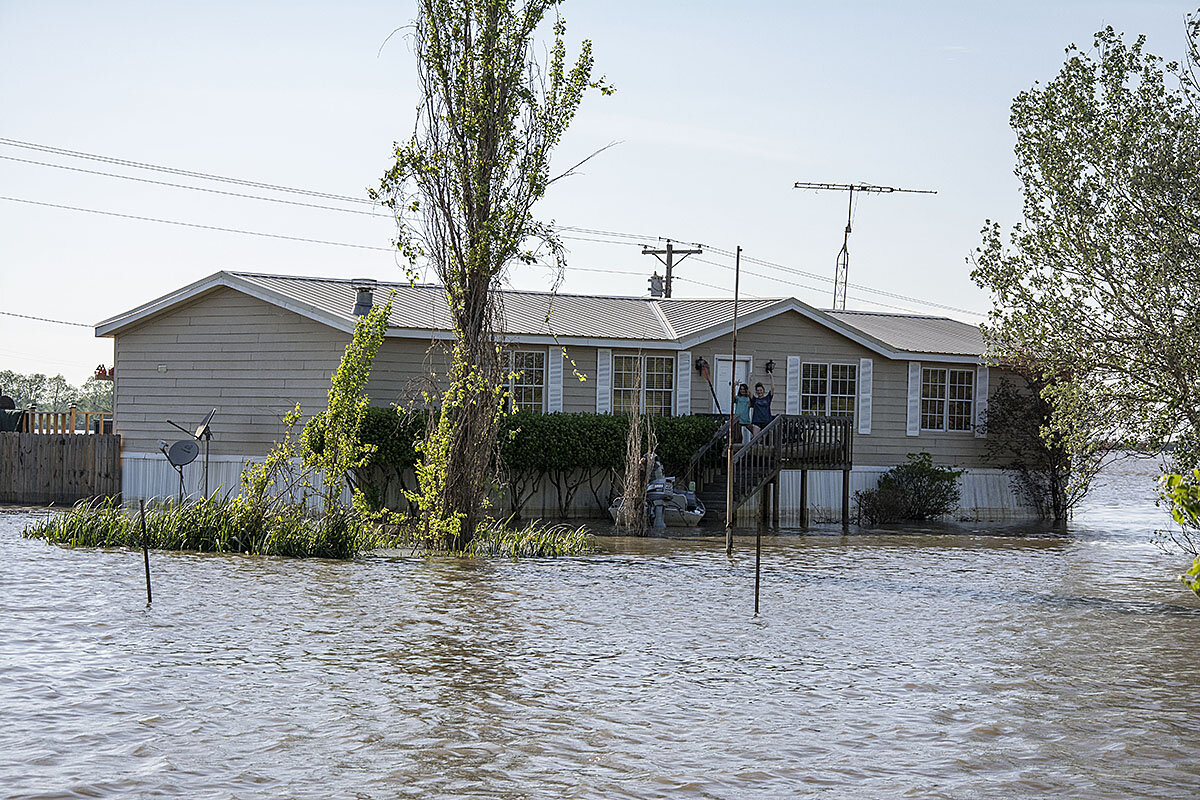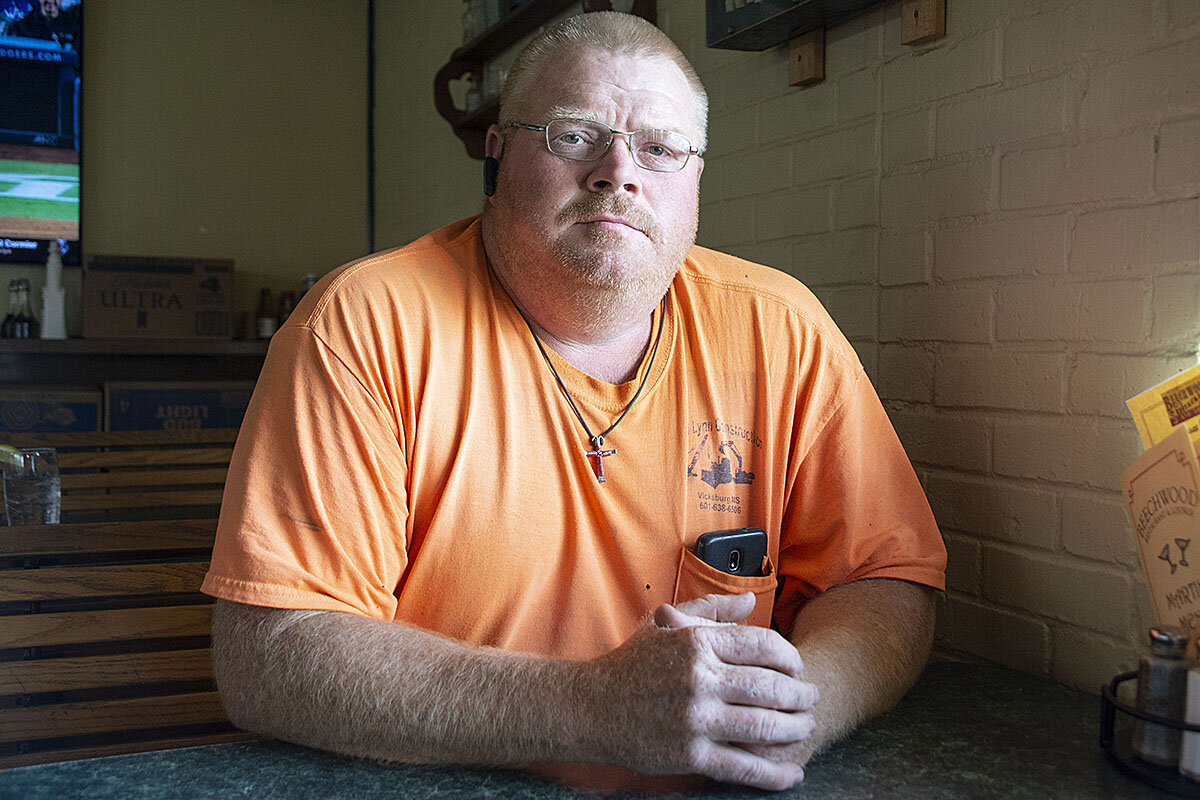Mississippi’s forgotten flood: When nation looks away, locals unite
Loading...
| Fitler, Miss.
His house had become an island. A ring of sandbags protected it from the stagnant water that filled the surrounding fields and covered the dirt road. But it didn’t keep out invaders.
Marooned at his Fitler, Mississippi, home for days at a time, Anderson Jones Sr. had to mount a defense. So he set up a metal folding chair under the carport, grabbed his shotgun, and waited.
It didn’t take long for them to come. Enticed by the dry land, snakes – usually cottonmouths – slithered over the sandbags. Crack, crack, the shots rang out. On one day, Mr. Jones says, he shot 12.
Why We Wrote This
Of course there’s no place like home. But following a flood that upended scores of lives this year, one Mississippian asks, “Should people be able to live anywhere they want and be protected?”
When the flood began in February, Mr. Jones’s family escaped to higher ground. But he was determined to defend his home.
That wasn’t a simple task. Mr. Jones has diabetes and was in a car accident in 1990 that left him walking with a cane and a brace on his leg. With his car parked on high ground a couple of miles away, a trip to the store for food or medication became an ordeal. He’d wade, boat, and sometimes drive a four-wheeler through the water.
But come mid-May, snakes were the least of his worries. The water was rising again, quickly this time, and threatening to breach the sandbag levee. Mr. Jones had lived through floods before, but he says, “2019 outdid all of them.”
More than half a million acres across several counties in Mississippi went underwater in late February, and remained submerged for more than six months. Two people drowned, hundreds of homes were affected, and about 220,000 acres of farmland went unplanted.
“It felt like it was never going to end,” says Victoria Darden, a farmer in Onward, Mississippi. “This has probably been the toughest year of my life.”
The floodwaters didn’t recede until early August, making the length of the flood one for the history books. But the flood left behind more than destroyed homes, empty fields, and black mold. It also left its mark on how residents see themselves and their place in the nation.
“Ain’t no place like home”
The Mississippi River holds a special place in American lore – both historical and fictional. It practically bisects the country and is the main route to the sea for American agricultural exports.
The river also drains 41% of precipitation that falls across the contiguous United States. That makes it the largest drainage basin in the world, covering more than 1,245,000 square miles across 31 states.
That’s a lot of water flowing through the more southerly states. Every second, approximately 3.7 million gallons of water rush by Vicksburg, Mississippi. That’s on an average day. When the river is above flood stage, that volume can more than triple.
Vicksburg’s elevation places it well out of the flood zone, but the wedge of land to the north between the Yazoo and Mississippi rivers is flat and low-lying. Today, tall levees line both rivers, constraining them to their channels. Floodgates drain rainwater out of that wedge of land, dubbed the Yazoo Backwater Area.
The stage was set for the extended backwater flooding long before Mr. Jones sloshed to his car. The 12-month period from July 2018 to June 2019 was the wettest the nation has ever experienced on record, swelling the Mississippi and Yazoo rivers above flood stage even before 2019 began. With the rivers already above capacity, the U.S. Army Corps of Engineers closed the floodgates. So when rain fell in the backwater area, there was nowhere for it to go.
“It just kept pushing up, kept coming,” Mr. Jones says. “By then it was too late to get anything out – I lost everything in the house.”
Mr. Jones and his son made a daring escape through the floodwaters at 2 a.m. on May 19. Water was rushing into the house, and Mr. Jones worried what might happen if it reached the electrical sockets. So in the dark and drizzle, father and son waded to the little boat, leaving their family home and everything remaining in it behind.
Mr. Jones walks through the house on a steamy October day, using his cane to point out a watermark about a foot above the floor on the beams that remain. The house has been stripped of its mold-infested contents. The interior walls are just frames. While many residents are tearing down their destroyed homes and starting fresh, Mr. Jones is determined to keep his childhood home.
“Ain’t no place like home,” he says.
Top of mind
Even after the land is dry, remnants of the flood linger in residents’ yards – and minds.
“A month ago when it started raining after it dried up, I was on edge,” Ms. Darden says. “How much is it going to rain? What is going to happen from here? We’d just dried out. It’s very nerve-wracking.”
The most obvious reminder comes from an intentional display. Handmade yard signs, bumper stickers, and spray-painted rooftops scheduled for demolition declare #FINISHTHEPUMPS. The hashtag refers to a pumping station that was part of a federal plan hatched in response to devastating flooding along the Mississippi River in 1927.
The plan included a system of levees, floodgates, pumps, and reservoirs to manage flood risk along the river and its tributaries. Bordered by levees keeping both the Mississippi and Yazoo rivers from overflowing into the land, the Yazoo Backwater Area came into being. There’s also a set of floodgates. They can be closed to keep river water from backing up into that wedge of land, or opened to drain rainwater from the land into the rivers.
The floodgates rely on gravity: The land will only drain if the river is lower than the water levels in the backwater area. So when the gates are closed and a lot of rain falls behind the levees, the water has nowhere to go. (That’s what happened this year.) The original plan included a pumping station that would drain some rainwater from the backwater area into the swollen rivers when the floodgates were closed.
But the pumps were never installed.
“They built us a bathtub and never built the drain,” says Redwood resident Stormy Deere, who boated to her elevated home for months.
The 2019 flood renewed calls for the pumps. Disgruntled residents like Ms. Deere formed a nonprofit organization called Finish the Pumps. They’ve also dubbed the natural disaster “The Forgotten Backwater Flood” to illustrate their sentiment of feeling left behind among national priorities.
Following decades of delays, the Environmental Protection Agency under the George W. Bush administration vetoed the project in 2008, citing environmental concerns. That veto is challenging to overturn, but it appears advocates for the pumps are gaining some traction now. On Oct. 21, the EPA broke from its long-kept distance and joined residents in a listening session.
“We have an ongoing dialogue with the U.S. Army Corps of Engineers (Corps) regarding potential options for providing flood protection,” the EPA said in a statement provided to the Monitor. “We remain committed to working actively and cooperatively with the Corps concerning our Clean Water Act programs to support a long-term viable solution.”
A cropless year
The field in front of Clay Adcock’s house in Holly Bluff should be a sea of white puffs. Cotton should have been ready for harvest in October. Instead, the only crop the land is producing is dust devils. This year was the first time in 33 years that commercial farmer Mr. Adcock didn’t plant anything.
The flood was a massive financial hit for the 6,000-acre operation, but Mr. Adcock says he’ll be alright. He built a levee around his home and much of his farm equipment that kept the water from causing extensive damage.
“I’m fortunate, I’ve got room enough to build a levee and I’ve got the money to do it, and so I could do it,” he says, estimating that he spent about $30,000 building the levee. “But there’s a world of people out there that cannot do that.”
Agricultural losses account for much of the financial hit of the flooding. As such, environmentalists like Louie Miller, state director of the Mississippi Chapter of the Sierra Club, have expressed concern that spending federal money to install the pumps would be catering too much to the economic interests of a select few.
Every dollar spent operating the pumps would yield $1.40 savings in flooding damage, according to 2007 Army Corps estimates. But that’s only after installation – which was priced at $200 million in 2008. That figure would likely be higher today.
A project of that scale would have to be federally funded. And getting approval for federal funds is tricky for such a sparsely populated area. It raises broader questions about our national infrastructure priorities, that resonate beyond the riverbanks of the Mississippi to coastal areas facing rising seas and intensifying hurricanes.
“That’s kind of a question for America writ large: Should people be able to live anywhere they want and be protected, or at least have the feeling of being protected from floods?” says Martin Doyle, a professor of river science and policy at Duke University who grew up in the Mississippi Delta.
“You wouldn’t want to be anywhere else”
For renters, a devastating flood can be especially destabilizing. Kenneth Parker had been saving up money to buy the land and the trailer home where he lived with his wife and their four children. But when water swept through his neighborhood in Eagle Lake, the trailer was destroyed and his landlady sold the plot to someone else.
“I had nothing to fall back on,” Mr. Parker says. “We lost everything.”
The family found a temporary place to stay in another county, but Mr. Parker now drives two hours each way to work while his wife home-schools their children. But Warren County is home for Mr. Parker, and he hopes to return.
There’s a silver lining to this year’s flood, says Ms. Darden. Neighbors have become closer friends and teammates, piling sandbags together and organizing calls to elected officials.
“In an average year, you couldn’t ask for a better place to live. The community is wonderful, the people are very caring … everybody helps everybody. It’s just tightknit, small-town USA,” Ms. Darden says. “I personally had not seen this community come together like this. It was very moving, very emotional – but you wouldn’t want to be anywhere else.”
The flood also left its mark on Ms. Darden.
Before, she wasn’t one to rock the boat. As a young female farmer, she was shy and kept her thoughts to herself. But as the flood wore on, she attended many community meetings. Older residents like Mr. Jones and Mr. Adcock spoke about the pumps, and she began to do some research about the history of flood control in the region. That’s when something changed in her.
“I don’t like politics,” Ms. Darden says. “But I know that it matters and if you want change, you’ve got to speak up, you’ve got to be involved in it. That’s the only way.” She now serves on the board of Finish the Pumps.
This story was produced with support from the Institute for Journalism & Natural Resources and from an Energy Foundation grant to cover the environment.












